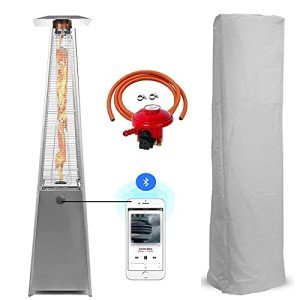Introduction To The Intermediate Guide To Patio Heating Systems
Patio Heating Systems: A Comprehensive Guide
As outdoor home progress into extensions of our homes, developing a comfortable and inviting atmosphere is critical. One of the most effective methods to achieve this convenience is by implementing patio heater. These systems enable friends and families to enjoy their outdoor spaces year-round, despite the chill of the evening air. This post will check out numerous patio heater available, their functions, benefits, and essential factors to consider for choosing the right one.
Kinds Of Patio Heating Systems
Patio heating systems can be found in numerous forms, each with its own unique qualities. Below are some of the most typical types:
Type
Description
Pros
Cons
Electric Patio Heaters
These heaters operate utilizing electrical energy and can be found in wall-mounted, portable, and freestanding models.
Easy to install and use; immediate heat; safe; low upkeep
Restricted heat range; might increase electricity expense
Gas Patio Heaters
Generally powered by propane or natural gas, gas patio heaters supply considerable heat output and can cover big areas.
High heat output; can last longer than electrical models; ideal for big events
Needs gas supply; can be less portable; safety issues with gas leaks
Infrared Heaters
Infrared heaters release thermal radiation that straight warms objects and people rather than the surrounding air.
Efficient; instant heat; minimal heat loss; eco-friendly options available
Minimal location of impact; initial expense may be high
Fire Pits
Typically made of stone or metal, fire pits offer warmth and ambiance, developing a relaxing environment.
Natural ambiance; flexible (cooking alternative); gather around for social interactions
Safety dangers with open flame; need wood or propane supply
Patio Umbrellas with Heaters
These are umbrellas fitted with integrated heating elements, ideal for shaded locations.
Convenient; combines shade and heating; portable
Less effective in windy conditions; limited area; can be costly
Secret Features to Consider
When selecting a patio heating system, it is important to evaluate numerous features based upon personal choices, spending plan, and outdoor space requirements. Here are some aspects to consider:
Heating Capacity: Measured in BTUs (British Thermal Units), this determines the heat output of the heater. Select a heater with adequate BTUs for your outdoor size.
Fuel Type: Decide in between electric, gas, or wood-burning options based upon benefit, accessibility, and efficiency.
Portability: If movement is important, look for lightweight or wheeled models for easy transport.
Maintenance: Consider the upkeep needed for each type. Electric heaters generally need less maintenance than gas or wood options.
Safety Features: Look for systems with safety cut-offs, protective screens, and materials that can withstand outdoor conditions.
Benefits of Patio Heating Systems
Patio heater provide a number of advantages, allowing property owners to maximize using their outdoor living locations. Some benefits consist of:
- Extended Outdoor Use: Heaters enable more time spent outside, even during cooler seasons.
- Increased Comfort: Provide a warm and inviting environment for gatherings, celebrations, or peaceful evenings.
- Enhanced Aesthetics: Many heater styles include a stylish touch to outdoor decor.
- Increased Property Value: Homes with fully equipped outdoor areas may bring in higher value and attract possible buyers.
- Versatile Options: With different designs and styles readily available, there is a heating option for each sort of outdoor setting.
FAQs About Patio Heating Systems
1. How much does it cost to run a patio heater?
- Electric Models: This depends on the regional electrical energy rates and usage time. Typically, running an electrical heater can cost between ₤ 0.10 to ₤ 0.50 per hour.
- Gas Models: Propane costs differ, but a 20-pound tank typically lasts about 8-10 hours, costing around ₤ 20-₤ 30 to fill.
2. Are patio heaters safe to use?
The majority of modern patio heaters are designed with safety features. However, it's necessary to follow safety procedures, such as adhering to clearances from flammable items, utilizing on steady surface areas, and guaranteeing correct ventilation for gas designs.
3. Do patio heaters work in windy conditions?
The majority of patio heaters can offer heat in light winds, however strong gusts can lower their efficiency and safety. For high-wind locations, think about more steady designs or utilize wind guards.
4. Can I utilize a patio heater inside?
Utilizing outdoor heaters inside your home is not recommended due to carbon monoxide gas dangers, especially with gas heaters. Always validate Click On this site 's intended use standards before setup.
5. How do I preserve my patio heating unit?
Regular upkeep is essential to guarantee longevity and efficiency:
- For electrical heaters, check and clean up the heating component routinely.
- Gas heaters must have their gas lines inspected for leakages and filters cleaned.
- Fire pits should be cleaned after usage and looked for any residue or ash buildup.
Patio heating systems play a crucial function in changing outdoor spaces into comfy and inviting environments. With a range of options, each with unique advantages and features, homeowners can select the ideal system based on their requirements, preferences, and particular outdoor conditions. By buying a trustworthy patio heater, one can make the most of satisfaction of their outdoor space throughout the year. Whether hosting summer season barbecues or cozying up on cool nights, a warmed patio welcomes togetherness, relaxation, and pleasure, making it an important addition to any home.
